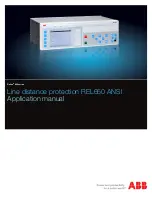
P846/EN AP/D
Application Notes
(AP) 6-6
MiCOM P846
AP
Reliability:
The DLO must detect the open-close status of a line at both ends for the
following categories of phenomena:
−
Line closing or opening at local end (with or without a shunt reactor connected)
−
Line opening at remote end (with or without a shunt reactor connected) with line
charging current measured by the DLO
−
Line closing at local end when already open at remote end. MW surge and line charging
measured by the DLO
−
Line opening at both ends with 100% compensation with shunt reactors
−
Line opening with residual CT current measured by the DLO
−
Closing of a line at remote end with DLO measuring line voltage and shunt reactor
current
Security:
False detections must be avoided in the following categories of phenomena:
−
Fault occurrence with reversal of current direction on the line
−
Low or very low power transfer on the monitored line
−
Distortion on line voltages and currents during faults
−
Fast variations in the line power flow
−
Reversal of power flow direction
−
Power
oscillations
−
Sub-synchronous resonances
−
Presence of harmonics
Speed:
The DLO must detect any change in the line status in 35 ms or less.
−
This response time includes the effects of the CTs magnetizing discharge currents, the
DLO internal filters and the delay of its output contacts.
2.3
Setting guidelines
The primary settings related to this protection functions can be found in the relay menu "VT
AND CT Ratio" needed to specify the DLO operation parameters.
Menu Text
Default setting
Setting range
Min. Max.
Step size
Main VT Primary
735kV
100V
1000kV
1V
Main VT Sec'y
120.0V
80V
140V
1V
Phase CT Primary
2000A
1A
30
1A or 0.01kA
Phase CT Sec'y
5.000A
1A
5A
4A
Phase CT2
Primary
2000A
1A
30
1A or 0.01kA
Phase CT2 Sec'y
5.000A
1A
5A
4A
CVT Enable
Enabled
Disabled/Enabled
CVT Threshold
10%
1
100
0.1%
Tie-Line Factor
Disabled
Disabled/Enabled
Base Power
2.081 GW
0
5.000G
1W
Line Charging
20.81 MVar
0
5.000G
1Var
Table 2 Primary settings of the DLO
Summary of Contents for MiCOM P846
Page 2: ......
Page 4: ......
Page 5: ...Safety Section P846 EN SS H11 SS SAFETY SECTION...
Page 6: ...P846 EN SS H11 Safety Section SS...
Page 8: ...P846 EN SS H11 Safety Section SS 2 SS...
Page 16: ...P846 EN IT D Introduction MiCOM P846 IT...
Page 18: ...P846 EN IT D Introduction IT 1 2 MiCOM P846 IT...
Page 26: ...P846 EN TD D Technical Data MiCOM P846 TD...
Page 38: ...P846 EN GS D Getting Started MiCOM P846 GS...
Page 58: ...P846 EN ST D Getting Started MiCOM P846 ST...
Page 60: ...P846 EN ST D Settings ST 4 2 MiCOM P846 ST...
Page 78: ...P846 EN OP D Operation MiCOM P846 OP...
Page 104: ...P846 EN OP D Operation OP 5 26 MiCOM P846 OP...
Page 106: ...P846 EN AP D Application Notes MiCOM P846 AP...
Page 108: ...P846 EN AP D Application Notes AP 6 2 MiCOM P846 AP...
Page 122: ...P846 EN AP D Application Notes AP 6 16 MiCOM P846 AP...
Page 124: ...P846 EN PL D Programmable Logic MiCOM P846 PL...
Page 126: ...P846 EN PL D Programmable Logic PL 7 2 MiCOM P846 PL...
Page 144: ...P846 EN MR D Measurements and Recording MiCOM P846 MR...
Page 146: ...P846 EN MR D Measurements and Recording MR 8 2 MiCOM P846 MR...
Page 160: ...P846 EN FD D Firmware Design MiCOM P846 FD...
Page 182: ...P846 EN CM D Commissioning MiCOM P846 CM...
Page 228: ...P846 EN CM D Commissioning CM 10 46 MiCOM P846 CM...
Page 230: ...P846 EN MT D Maintenance MiCOM P846 MT...
Page 232: ...P846 EN MT D Maintenance MT 11 2 MiCOM P846 MT...
Page 238: ...P846 EN TS D Troubleshooting MiCOM P846 TS...
Page 240: ...P846 EN TS D Troubleshooting TS 12 2 MiCOM P846 TS...
Page 252: ...P846 EN SC D SCADA Communications MiCOM P846 SC...
Page 272: ...P846 EN SG D Symbols and Glossary MiCOM P846 SG...
Page 280: ...P846 EN SG D Symbols and Glossary SG 14 8 MiCOM P846 SG...
Page 282: ...P846 EN IN D Installation MiCOM P846 IN...
Page 284: ...P846 EN IN D Installation IN 15 2 MiCOM P846 IN...
Page 296: ...P846 EN IN D Installation IN 15 14 MiCOM P846 IN...
Page 297: ......















































